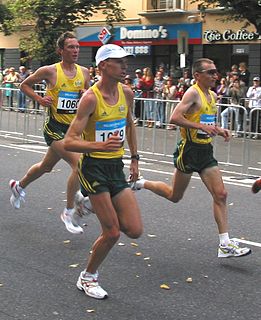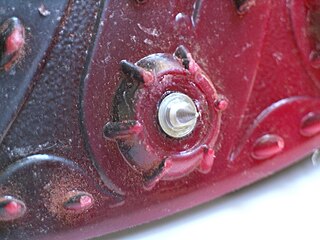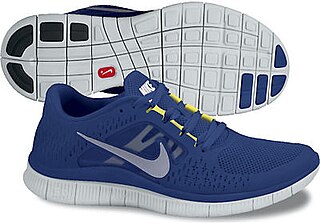
The foot is an anatomical structure found in many vertebrates. It is the terminal portion of a limb which bears weight and allows locomotion. In many animals with feet, the foot is a separate organ at the terminal part of the leg made up of one or more segments or bones, generally including claws or nails.

Running is a method of terrestrial locomotion allowing humans and other animals to move rapidly on foot. Running is a type of gait characterized by an aerial phase in which all feet are above the ground. This is in contrast to walking, where one foot is always in contact with the ground, the legs are kept mostly straight and the center of gravity vaults over the stance leg or legs in an inverted pendulum fashion. A feature of a running body from the viewpoint of spring-mass mechanics is that changes in kinetic and potential energy within a stride occur simultaneously, with energy storage accomplished by springy tendons and passive muscle elasticity. The term running can refer to any of a variety of speeds ranging from jogging to sprinting.

A shoe is an item of footwear intended to protect and comfort the human foot. Shoes are also used as an item of decoration and fashion. The design of shoes has varied enormously through time and from culture to culture, with appearance originally being tied to function. Though the human foot is adapted to varied terrain and climate conditions, it is still vulnerable to environmental hazards such as sharp rocks and temperature extremes, which shoes protect against. Some shoes are worn as safety equipment, such as steel-soled boots which are required on construction sites.

A gait is a pattern of limb movements made during locomotion. Human gaits are the various ways in which a human can move, either naturally or as a result of specialized training. Human gait is defined as bipedal, biphasic forward propulsion of the center of gravity of the human body, in which there are alternate sinuous movements of different segments of the body with least expenditure of energy. Different gait patterns are characterized by differences in limb-movement patterns, overall velocity, forces, kinetic and potential energy cycles, and changes in the contact with the ground.

Flat feet is a postural deformity in which the arches of the foot collapse, with the entire sole of the foot coming into complete or near-complete contact with the ground.

Track spikes, or just spikes, are racing shoes used by athletes when racing on the track. Some spikes are designed for longer-term training on tracks, but generally the shoes are used for racing. The term "spikes" can also refer to track shoes featuring such protrusions, though these are technically called pins. Spikes are similar to studs, which are used for team sports, although generally smaller and with a sharp point.

Nike Free is a minimalist running shoe. It was introduced in 2005 after Nike representatives observed Nike sponsored track athletes training barefoot.

Barefoot running, also called "natural running", is the act of running without footwear. With the advent of modern footwear, running barefoot has become less common in most parts of the world but is still practiced in parts of Africa and Latin America. In some Western countries, barefoot running has grown in popularity in the 2000s due to perceived health benefits.

Pronation is a natural movement of the foot that occurs during foot landing while running or walking. Composed of three cardinal plane components: subtalar eversion, ankle dorsiflexion, and forefoot abduction, these three distinct motions of the foot occur simultaneously during the pronation phase. Pronation is a normal, desirable, and necessary component of the gait cycle. Pronation is the first half of the stance phase, whereas supination starts the propulsive phase as the heel begins to lift off the ground.

Nike Flywire is a thread, composed of vectran or nylon, developed by Nike to minimize weight and maximize support, and used in the upper of a sneaker. Shoes containing Flywire became available for consumer purchase in 2008.

Vibram FiveFingers are a type of minimalist shoe manufactured by Vibram, originally marketed as a more natural alternative for outdoor activities. The footwear is meant to replicate being barefoot and has thin, flexible soles that are contoured to the shape of the human foot, including visible individual sections for the toes. The company settled a lawsuit alleging false health claims and set aside $3.75 million to pay refunds of up to $94 to anyone who had purchased the product since March 21, 2009.

Locomotor effects of shoes are the way in which the physical characteristics or components of shoes influence the locomotion neuromechanics of a person. Depending on the characteristics of the shoes, the effects are various, ranging from alteration in balance and posture, muscle activity of different muscles as measured by electromyography (EMG), and the impact force. There are many different types of shoes that exist, such as running, walking, loafers, high heels, sandals, slippers, work boots, dress shoes, and many more. However, a typical shoe will be composed of an insole, midsole, outsole, and heels, if any. In an unshod condition, where one is without any shoes, the locomotor effects are primarily observed in the heel strike patterns and resulting impact forces generated on the ground.
Cross country running shoes are made for cross country running, a form of long distance running. Season-specific trainers are available for different types of training.
Altra Running, commonly known as Altra, is an American manufacturing company engaged in the design, development, marketing, and sales of athletic shoes for road running, trail running, and general footwear. Altra has been ranked in the top 10 brands in “run specialty” and number 4 for trail running.

Minimalist shoes are shoes intended to closely approximate barefoot running or walking conditions in comparison to traditional shoes. They have reduced cushioning, thin soles, a wide toe box, and are of lighter weight than other running shoes, allowing for more sensory contact for the foot on the ground while simultaneously providing the feet with some protection from ground hazards and conditions. Research shows that wearing a minimalist shoe can help improve foot strength and arch function.

Xero Shoes is a type and brand of lightweight minimalist footwear manufactured by Feel the World Inc. Designed for walking, running, and athletics, the footwear has thin and flexible soles that are contoured to the shape of the human foot. Xero Shoes was featured on ABC's Shark Tank and gained success after the show's appearance.
Hoka One One is an athletic shoe company originating in France that designs and markets running shoes. The brand first gained attention in the running industry by producing shoes with oversized outsoles, dubbed "maximalist" shoes due to extra cushion; this was in contrast to the minimalist shoes trend that was gaining popularity at the time of the company's founding in 2009.

The Reebok Nano is the first official athletic shoe specifically designed for CrossFit. The first generation of the shoe was released in 2011.

Barefoot is the most common term for the state of not wearing any footwear.
Running injuries affect about half of runners annually. The frequencies of various RRI depend on the type of running, such as speed and mileage. Some injuries are acute, caused by sudden overstress, such as side stitch, strains, and sprains. Many of the common injuries that affect runners are chronic, developing over longer periods as the result of overuse. Common overuse injuries include shin splints, stress fractures, Achilles tendinitis, Iliotibial band syndrome, Patellofemoral pain, and plantar fasciitis.
















